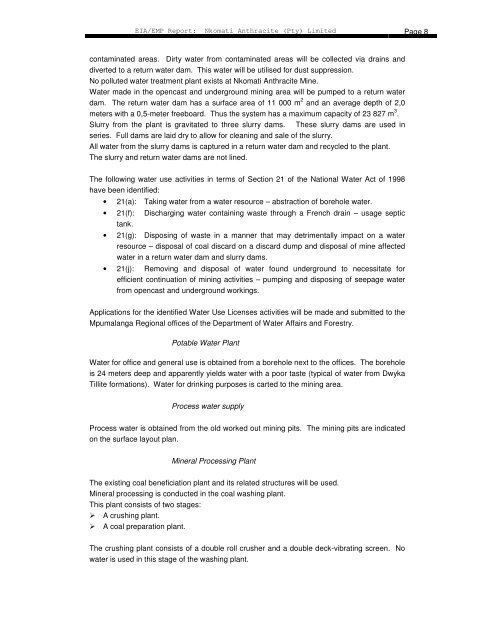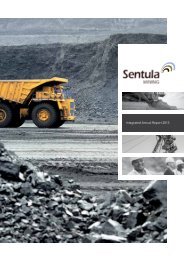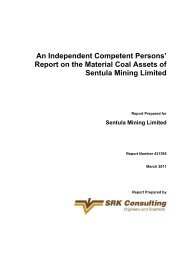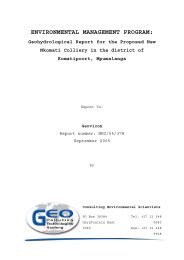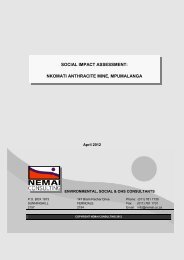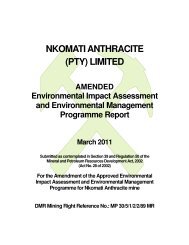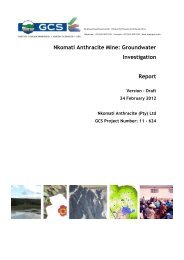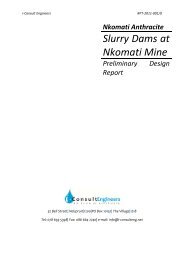EMP - EIA - Sentula Mining
EMP - EIA - Sentula Mining
EMP - EIA - Sentula Mining
You also want an ePaper? Increase the reach of your titles
YUMPU automatically turns print PDFs into web optimized ePapers that Google loves.
<strong>EIA</strong>/<strong>EMP</strong> Report: Nkomati Anthracite (Pty) Limited<br />
contaminated areas. Dirty water from contaminated areas will be collected via drains and<br />
diverted to a return water dam. This water will be utilised for dust suppression.<br />
No polluted water treatment plant exists at Nkomati Anthracite Mine.<br />
Water made in the opencast and underground mining area will be pumped to a return water<br />
dam. The return water dam has a surface area of 11 000 m 2 and an average depth of 2,0<br />
meters with a 0,5-meter freeboard. Thus the system has a maximum capacity of 23 827 m 3 .<br />
Slurry from the plant is gravitated to three slurry dams. These slurry dams are used in<br />
series. Full dams are laid dry to allow for cleaning and sale of the slurry.<br />
All water from the slurry dams is captured in a return water dam and recycled to the plant.<br />
The slurry and return water dams are not lined.<br />
The following water use activities in terms of Section 21 of the National Water Act of 1998<br />
have been identified:<br />
• 21(a): Taking water from a water resource – abstraction of borehole water.<br />
• 21(f): Discharging water containing waste through a French drain – usage septic<br />
tank.<br />
• 21(g): Disposing of waste in a manner that may detrimentally impact on a water<br />
resource – disposal of coal discard on a discard dump and disposal of mine affected<br />
water in a return water dam and slurry dams.<br />
• 21(j): Removing and disposal of water found underground to necessitate for<br />
efficient continuation of mining activities – pumping and disposing of seepage water<br />
from opencast and underground workings.<br />
Applications for the identified Water Use Licenses activities will be made and submitted to the<br />
Mpumalanga Regional offices of the Department of Water Affairs and Forestry.<br />
Potable Water Plant<br />
Water for office and general use is obtained from a borehole next to the offices. The borehole<br />
is 24 meters deep and apparently yields water with a poor taste (typical of water from Dwyka<br />
Tillite formations). Water for drinking purposes is carted to the mining area.<br />
Process water supply<br />
Process water is obtained from the old worked out mining pits. The mining pits are indicated<br />
on the surface layout plan.<br />
Mineral Processing Plant<br />
The existing coal beneficiation plant and its related structures will be used.<br />
Mineral processing is conducted in the coal washing plant.<br />
This plant consists of two stages:<br />
A crushing plant.<br />
A coal preparation plant.<br />
The crushing plant consists of a double roll crusher and a double deck-vibrating screen. No<br />
water is used in this stage of the washing plant.<br />
Page 8


